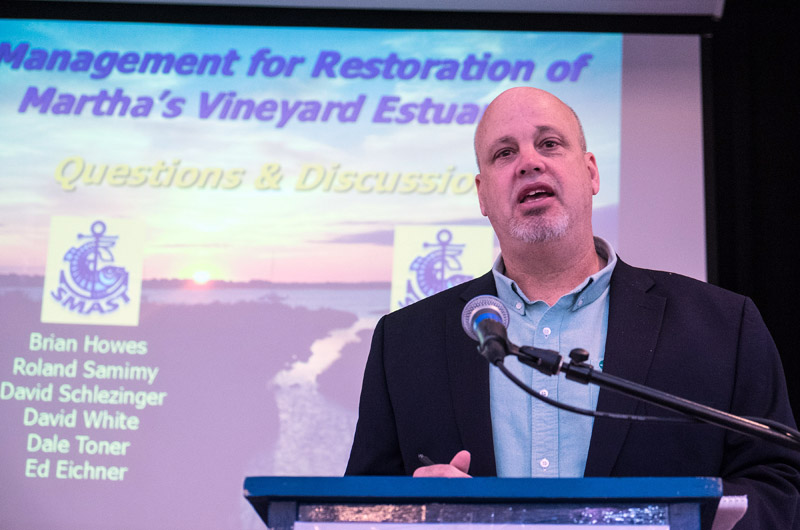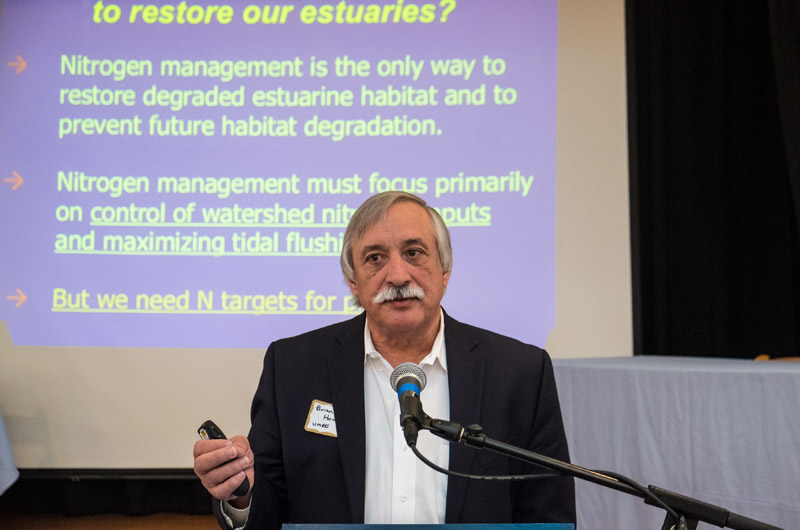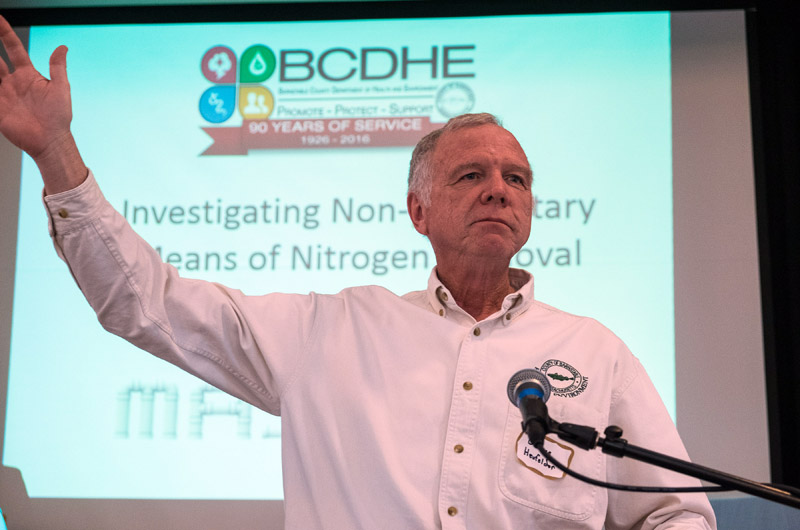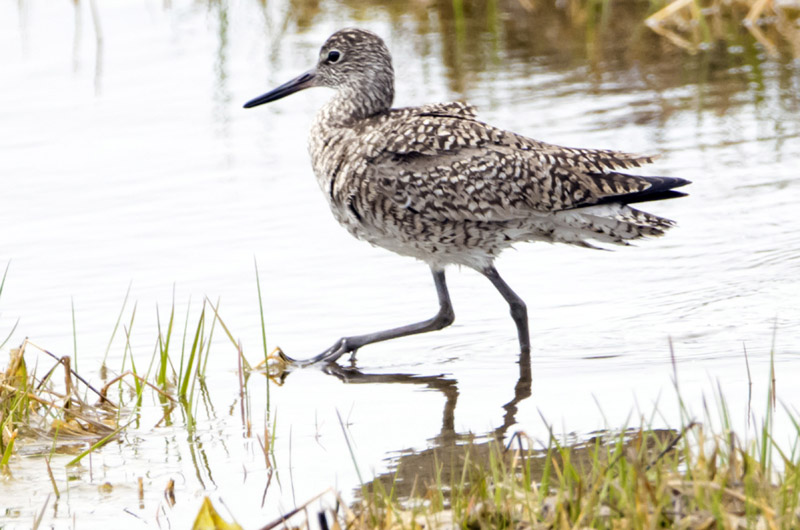Leading water quality experts gathered in West Tisbury on Thursday to lay out some of the solutions to declining pond health on the Vineyard.
Hosted by the Martha’s Vineyard Commission, the daylong conference at the Grange Hall was the first of its kind on the Vineyard. It follows a growing awareness of the influence of land use changes on the Island’s saltwater ponds, especially the effect of nitrogen from septic tanks and other sources.

Commission executive director Adam Turner, who took over the position last year, has made water quality a top priority for the regional planning and agency.
In opening remarks, MVC chairman Jim Vercruysse noted that water follows no political boundaries, highlighting a need for collaboration.
“We have done a great job of documenting our problems,” Mr. Vercruysse said. “And today we focus on solutions.” Among other things, he said he hoped the conference would shed light on how the commission could use its regulatory powers to greater effect.
The program ran the gamut of potential solutions, from sewering to aquaculture, and the need for continued data and monitoring. Speakers in the morning pointed to a possible uphill battle, especially with newer and less proven technology, but also noted the economic opportunities that may arise.
Michael Giggey, senior vice president of the engineering firm Wright-Pierce, compared traditional and nontraditional approaches to nitrogen management. In both cases, he said, solutions will need to address nitrogen in three places: at the source, in the groundwater and in the ponds. Prevention is a key piece of the puzzle, he said.
A report by Wright-Pierce in 2010 is the only comprehensive wastewater management study for the Island. Among other things, the plan weighs the costs and benefits of sewering, and could serve as a general guide in the absence of a comprehensive regional wastewater plan as required by the Clean Water Act.
MVC water quality planner Sheri Caseau said Thursday the commission has discussed breaking the plan into up-Island and down-Island components, or possibly working with the Cape Cod Commission to develop its own regional wastewater plan. “It’s going to take a lot of time and cost a lot of money,” she said at the conference.
Traditional approaches such as sewering and some advanced septic systems have the benefit of a proven track record and possible economies of scale. But in general, Mr. Giggey said, the high cost of those approaches has driven an interest in alternatives such as constructed wetlands, urine-diverting toilets and other approaches. The benefits for those solutions may come quickly, he said, but government permitting is still a hurdle.
“There has to be a measurement that’s viable,” he said of each alternative. “How do you measure what it’s actually achieving?” New technologies may require extensive testing, adding to the challenge.
Maggie Theroux of the EPA Office of Research and Development spoke about efforts to streamline the regulatory process for nitrogen-reducing technology. Among other things, Ms. Theroux has worked to reduce the required number of field tests from 75 to 12 in some states.
In an Island survey last year, coastal water quality topped a list of potential priorities for the MVC, above transportation, housing and open space protection. Growing awareness in recent years has reached a tipping point as various groups begin taking steps to reduce the effects of land use changes that have altered most ponds on the Vineyard.
The Cape Cod Commission, which was modeled after the MVC, has taken the lead in planning efforts related to the 53 major estuaries on the Cape, most of which are severely impaired. Efforts on the Vineyard are aimed mostly at avoiding disaster.

Most experts agree that the problem is our own making. Too much nitrogen from septic systems, fertilizer and other sources cause algal blooms that deprive saltwater ponds of sunlight and oxygen, leading to a loss of eelgrass, shellfish and other organisms.
The Massachusetts Estuaries Project, a partnership between the state Department of Environmental Protection and the University of Massachusetts, has developed exhaustive reports and nitrogen budgets for most coastal ponds in the state. Technical director Brian Howes said Thursday that nitrogen threatens saltwater ponds around the world, but that the Vineyard ponds are still in relatively good condition. “You are actually just slightly over the limit most of the time, and that means it will be easier, cheaper and quicker to bring them back,” he said. The main indicator of estuarine health in the region has been eelgrass, which thrives in clear water, and supports shellfish and other pond organisms. More than half of the eelgrass in southeastern Massachusetts has disappeared.
Data will be key in moving forward, Mr. Howes said, and much of the baseline data for the Vineyard already exists, thanks to the MEP. After 14 years, the project is now moving into a new phase focused more on solutions than gauging the problem. But data will still play a key role as towns develop strategies to meet nitrogen budgets.
Mr. Howes noted a growing interest in aquaculture as a way to remove nitrogen from the water.
Funding from the DEP will end this year, but Mr. Howes said he envisions the university playing a more central role as the MEP works with towns to provide data. Already the MEP has run scenarios for sewering around Lagoon and Sengekontacket ponds, and for improving circulation at the head of the Lagoon by installing a small pipe through a berm.
Rick Karney, executive director of the Martha’s Vineyard Shellfish Group and also a speaker at the conference, said he was pleased to see the MEP shift its focus away from sewering to more innovative solutions. “It’s refreshing to see attitudes changing,” he said.
Much attention in recent years has focused on innovative-alternative septic systems that can remove nitrogen as well as bacteria. The systems have become a central part of the commission’s tool kit for regulating development in nitrogen-sensitive watersheds, but the technology itself is relatively new.

George Heufelder, director of the Massachusetts Alternative Septic System Test Center in Buzzards Bay, spoke about his groundbreaking work on alternative septic system technology. Mr. Heufelder monitors about 2,000 systems between Woods Hole and Provincetown, and says they remove about 55 per cent of the nitrogen in wastewater about 77 per cent of the time. At the test center, he has achieved much greater reductions, although he said those technologies require additional testing.
As many as 300 alternative systems have been installed on the Vineyard so far, mostly in Oak Bluffs and Edgartown. The systems are more expensive than conventional systems, but more cost effective than sewering in terms of nitrogen removal. The 2010 Wright-Pierce report found that new sewer lines on the Island could cost between $40,000 and $90,000, per property, compared to around $30,000 for an alternative system.
As with the other speakers, Mr. Heufelder stressed the importance of monitoring.
“If you don’t monitor, it won’t work,” he said.
Mr. Turner said the commission will also be focusing on monitoring in the future, so that when solutions are in place, the data will comply with state regulations. But he said the commission is off to a good start with data collected so far.
“We need to act strategically,” he said. “There will be many solutions.”





Comments (4)
Comments
Comment policy »